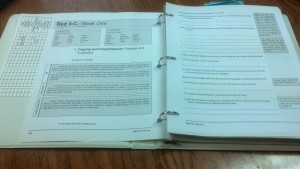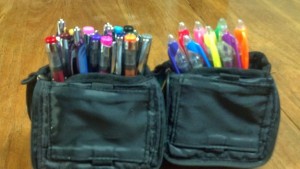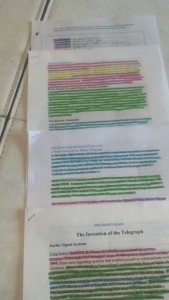
In my curriculum books (Character Quality Language Arts, a complete Christian language arts program for grades two through twelve, and Meaningful Composition, composition books for grades two through twelve), I teach an approach to research called “The Overview Source Method.”

One of the language arts books I have written, Character Quality Language Arts Red Book–Level C (high school)
I happened upon this method years ago as I was teaching kids how to write research reports. I have always taught students to write using a paragraph-by-paragraph method. (I don’t like the 100 word report, etc., approach as writings {essays, reports, and even books}.)
In the paragraph-by-paragraph method, the student decides ahead of time what each paragraph in an essay or report is going to be about. This early determination helps him in his research, choosing of quotations, sequencing, and more. To use this method in research writing, a student must work in this order: (1) Choose topic; (2) Research enough to write thesis statement (and write it); (3) Choose paragraph topics (from the source(s); (4) Research each paragraph’s topics/take notes.

Highlighters and colored pens are musts for research in the Overview Source Method and Color Coded Research approach
When a young student (third or fourth grade, for instance) writes a research report, he is usually just starting out with the myriad of skills that are involved in writing a research report, so he generally begins just using one source. That is fairly simple–his teacher helps him choose a good source, such as an encyclopedia entry or web site, a source that has a lot of headers, sub-headers, sidebars, etc. to help him determine his paragraph topics.
As students proceed through middle school, however, my expectations in research writing are heightened. I want the student to begin using multiple sources for one paper. I want him to learn how to merge a few sources (two at first) into one paper. This multi-source research can be especially challenging in the beginning.

One of the students in my classes to test my books–working on his Overview Source Method and Color-Coded Research
Thus, “The Overview Source Method” of research to the rescue!
In this method, the student chooses his first source, his “Overview Source.” This source will be the first source he consults in laying out his paragraph topics. It will be the first source that he uses to start taking notes beneath each paragraph topic. It will be the source that helps him determine what each paragraph of his report will contain.
One of the beauties of the “Overview Source Method” is that once a student learns it in, say, sixth grade, he has a skill for life. He can continue to use this approach all through his high school years and even into college.
Choose a source that has any or all of the following:
a. Headers and sub-headers that provide a sort of “outline” of the topic (Hint: At first, I tell my young students to find these great headers and choose three of them to be the paragraph topics (for three paragraphs) for his report!)
b. Glossary or other place where terms are defined
c. At least four times the number of paragraphs that the student is assigned to write. (If he chooses a six paragraph source for a four paragraph paper, he is back to using almost everything in that source, and he will not learn to choose the parts of information he wants to use in his paper.)
Once he chooses his Overview Source, he does any or all of the following:
1. Finds the headers that are above the material that he wants to use in his report. We start out telling students to choose one aspect or sub-topic of the topic per paragraph. (This also solves ALL paragraph break problems! No more running paragraphs together!)
2. Begin the Color-Coded Research (more on that later!) by highlighting each header in the Overview Source with a different color.
3. Using the color of the first header you chose for your first aspect (and first paragraph), highlight everything about that topic that you think you might want to take notes on for your paragraph in that first paragraph.
4. Using your other source(s), continue with that first color of highlighter. Find information about that color’s topic and highlight anything in the second source that you might want to use in your notes.
5. Continue doing Steps 3 and 4 for each aspect/paragraph.

I will write another post on the Color-Coded Research in more detail later. In the meantime, teach your students to use the Overview Source Method–that is, find one good, solid source that will help him to determine his paragraph topics. These are the initial baby steps to research that will build confidence in your student to write longer and more detailed research reports in the future.




